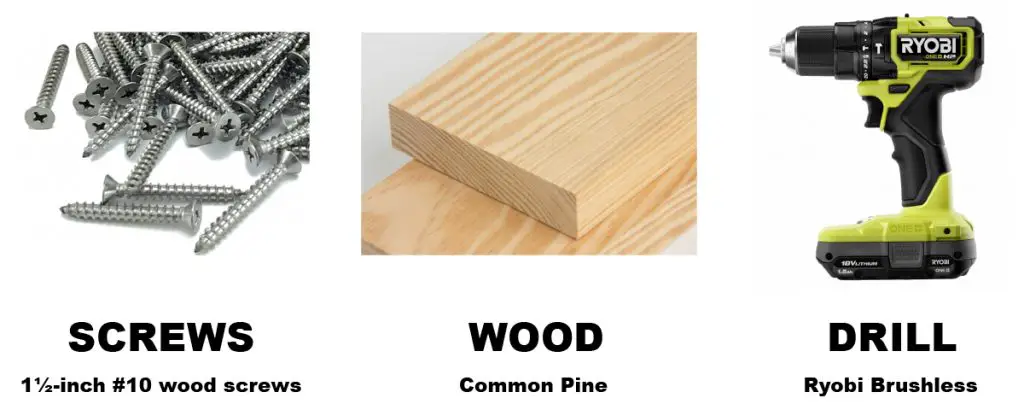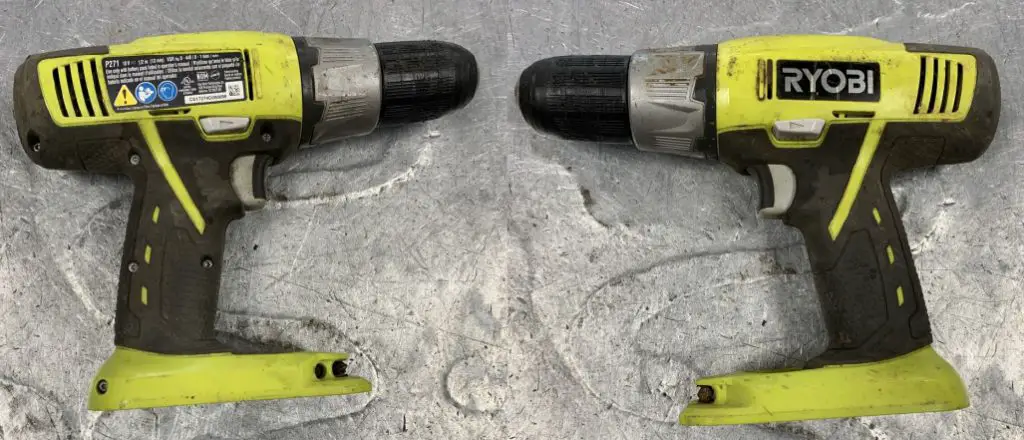Ryobi 18v batteries come in different capacities. The total amp-hours decide how long it will last in a single charge.
Following is the list of Ryobi 18v Lithium-Ion Batteries:
- 18V 1.5Ah Lithium Battery (PBP002)
- 18V 2Ah Lithium Battery (PBP003/PBP006)
- 18V 4Ah Lithium Battery (PBP005)
- 18V 6Ah Lithium High Capacity Battery (P193)
- 18V 9Ah Lithium High Capacity Battery (P194)
Many factors affect the total run-time for Ryobi 18v Batteries. Therefore, I have selected a medium-duty task of driving 1½-inch #10 wood screws into a common pine to find how long a single battery will last on a single charge.

How Long Do Ryobi 18v Batteries Last?
A Ryobi 18v 1.5Ah battery can last a continuous 32 mins for medium to heavy-duty tasks, like driving 1½-inch #10 wood screws into common pine.

A Ryobi 18v 2.0Ah (PBP003/PBP006) battery can last a continuous 41 mins for medium to heavy-duty tasks, like driving 1½-inch #10 wood screws into common pine.

A Ryobi 18v 4.0Ah battery can last a continuous 1 Hour 16 Mins for medium to heavy-duty tasks, like driving 1½-inch #10 wood screws into common pine.

A Ryobi 18v 6.0Ah battery can last a continuous 1 Hour 58 Mins for medium to heavy-duty tasks, like driving 1½-inch #10 wood screws into common pine.

A Ryobi 18v 9.0Ah battery can last a continuous 2 Hour 43 Mins for medium to heavy-duty tasks, like driving 1½-inch #10 wood screws into common pine.

| Ryobi Battery | Ryobi Drill | Screw Size | Material | Runtime | Total Screws |
|---|---|---|---|---|---|
| 18V 1.5Ah | 1/2″ Brushless | 1½-inch #10 wood screws | Common Pine Wood | 32 mins | 193 |
| 18V 2.0Ah | 1/2″ Brushless | 1½-inch #10 wood screws | Common Pine Wood | 41 mins | 243 |
| 18V 4.0Ah | 1/2″ Brushless | 1½-inch #10 wood screws | Common Pine Wood | 1 Hour 16 mins | 478 |
| 18V 6.0Ah | 1/2″ Brushless | 1½-inch #10 wood screws | Common Pine Wood | 1 Hour 58 mins | 729 |
| 18V 9.0Ah | 1/2″ Brushless | 1½-inch #10 wood screws | Common Pine Wood | 2 Hour 43 mins | 1092 |
Factors Affecting Total Runtime of Ryobi 18v Battery
The total runtime of a Ryobi 18v battery largely depends on multiple factors and can vary from one situation to another.
Battery Size of Ryobi 18v:
The first thing which affects the overall runtime of a Ryobi 18v battery is the amp hours. Amp hours is the amount of continuous current a battery can provide for one hour.
Current then translates into the amount of power a battery can deliver.
Power Output = Voltage x Amp-Hour
Below is a chart for how many watts a Ryobi 18v battery can provide for a fixed duration before it runs out of charge.
These are theoretical numbers. The actual figures will be 10%-15% lower. The overall capacity will drop 20% after 300-500 cycles of usage.
| Ryobi 18v Battery | Power Output (1 Hour) | Power Output (30 Mins) | Power Output (15 Mins) |
|---|---|---|---|
| 18V 1.5Ah | 27 Watts | 54 Watts | 108 Watts |
| 18V 2.0Ah | 36 Watts | 72 Watts | 144 Watts |
| 18V 4.0Ah | 72 Watts | 144 Watts | 292 Watts |
Type of Work You Are Using Yous Ryobi 18v Battery For:
As explained in the last heading, the overall run-time of a Ryobi 18vbattery largely depends on what task are you doing.
For example, drilling in concrete will yield low runtimes, while driving screws in softwood will give phenomenal runtimes.
Similarly, a circular saw cutting a soft wooden board will yield different results than a hard oak wood block.
The run-time is directly proportional to usage and power output. Below is a very rough comparison.
| 18 Battery | Task | Material | Runtime |
|---|---|---|---|
| 18V 2.0Ah | Drilling | Soft Wood | 20-30 Mins |
| 18V 2.0Ah | Drilling | Hard Wood | 15-20 Mins |
| 18V 2.0Ah | Drilling | Concrete | 10-15 Mins |
Operating Temperature of Ryobi 18v Battery:
The total runtime of an 18V Ryobi lithium-ion battery highly depends on the battery temperature. The temperature of the battery also affects the battery’s overall cycles.

Ryobi 18v batteries come with a temperature sensor. As soon as the temperature reaches a set threshold, a Ryobi tool will stop working to avoid damage to your 20V HART battery.
Run-Cycles Vs. The runtime of Ryobi 18v Battery:
The overall run time of a Lithium-Ion Ryobi 18v battery drops as it ages. Following is a chart describing the runtime of a 2oV 2 Amp Hour Battery after a certain number of run cycles.

Brushed vs. Brushless Motor:
Brushless motors are a lot more energy efficient than brushless motors. The energy efficiency comes due to the absence of physical brush contacts present in brushed motors.
The contacts produce a lot of heat and waste energy. So, the overall runtime of a Ryobi 18v battery dramatically depends on the type of motor used in your tool.
All Ryobi tools are NOT powered by BRUSHLESS motors, so the runtime can be slighlty lower for non-brusless tools than mentioned above.
Below is a great video to understand the differences between a brushed and brushless motor.
Condition of Your Ryobi Cordless Tool:
A brand new Ryob tool will run longer than an old one on the same battery. New tools are efficient with minimal friction inside their mechanical components.

The losses inside an old clumsy Ryobi tool will yield lower run times. So make sure your tools are properly lubricated and in good condition before planning to change your batteries.
How Long Will a Ryobi 18V Battery Last in term Life Cycle?
Ryobi 18V Batteries are lithium-ion batteries. Ryobi uses high-quality Li-Ion cells, which last longer than low-quality cheap drills, which cost the same as a Ryobi drill Battery with a battery and charger.
Under normal conditions, your drill battery will last 4-6 years or 500-800 cycles. The overall life of your Ryobi battery highly depends on operating temperatures, workload, charging & discharging behavior.
Operating Temperatures:
The overall life cycle of an 18V Ryobi battery highly depends on the operating temperatures.
Below is a graph showing the effect of temperature vs. Life Cycles of a Ryobi 18V Battery.

Charging and Discharging Behaviour:
Ok, so there are a few things you should take care of related to your 18V Lithium-ion Ryobi batteries.
For the best overall life cycle, the best practice is to recharge your battery as soon as your tool starts showing signs of a lower battery.
Don’t wait for your battery to fully discharge before you charge it again to avoid losing life cycles.
Another thing you should take care of is to avoid storing a fully charged or fully discharged battery. This is the biggest reason for destroying your battery life cycle.
Fully charged batteries affect the internal chemistry if kept for a long term, like a few weeks or months.
Similarly, a fully discharged Ryobi 18V battery will keep losing charge and reach a point where the terminal voltage is too low to be detected by a charger.
This will also affect your Ryobi battery’s overall life.
How Long Does it Take to Charge an 18V Ryobi Battery?
Different Ryobi batteries will require different amounts of time to fully charge. The charging time is also dependent on the type of charger being used.
Fast chargers usually take 15-18 mins to fully charge a 1 Amp-Hour battery. Slow conventional chargers are much slower and will take around 1 hour to charge a 1.0 amp hour Ryobi battery.
| Ryobi Battery | Fast Charger | Slow Charger |
|---|---|---|
| 18V 1.5Ah | 28 Mins | 1 Hour 10 Mins |
| 18V 2.0Ah | 34 Mins | 1 Hour 43 Mins |
| 18V 4.0Ah | 1 Hour 18 Mins | 3 Hour 08 Mins |
| 18V 6.0Ah | 2 Hour 08 Mins | 4 Hour 40 Mins |
| 18V 9.0Ah | 3 Hour 12 Mins | 7 Hour 20 Mins |
Additional Read: